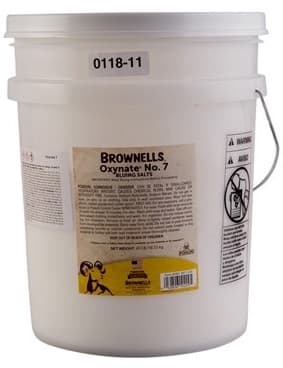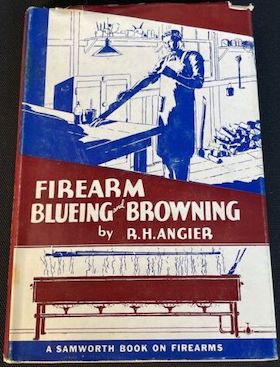
-----
Some Gun Bluing Shop Problems & Solutions
Q. My caustic bluing solutions gets weak.
Hi. I have my bluing solution that works well once I dissolve the chemicals: 650 gm caustic soda ⇦liquid caustic soda in bulk on
Amazon [affil link]
plus sodium nitrite 200 gm per liter. Once I blue some materials then the oxidation becomes weak despite that all the materials being blued are typically cleaned by degreaser.
What I mean by weak solution is that I notice poor coverage on the surface of the materials
Ali zhrani- Western /jeddah
March 7, 2021
January 8, 2022
A. Hi, I have been telling since 2013. I use Oxynate 7 from Brownells. I am not as familiar with the chemicals you use as you are so, I can't explain your particular problem. I would switch to Oxynate 7. I know all these chemicals are expensive. But, it is a chemical you can add to the mixture if it weakens
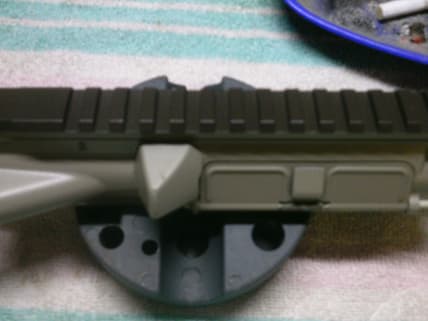
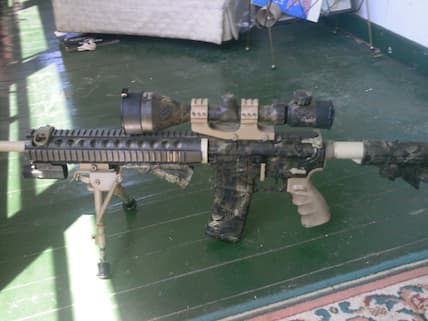
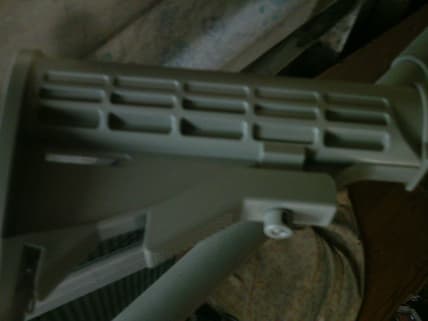
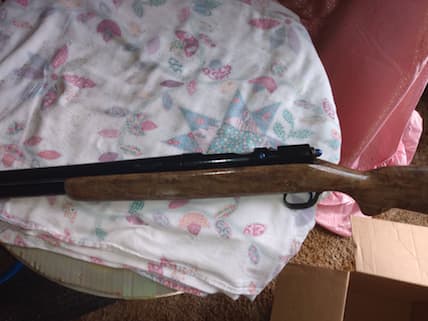
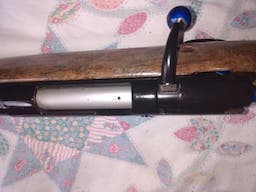
Duracoat is also a great firearm finish. It is a spray-on but made for firearms; has to be sandblasted off.
These are all duracoated then hydrographically dipped. That is my speciality but I did start with hot factory rebluing in 2013 and reblued barrels for a gunsmith in Maine during the winter for 2 years
- Pennington Gap [Virginia]
⇩ Related postings, oldest first ⇩
Q. Can't cold blue 12-gauge shotgun, Winchester 91. I have a Winchester mod 91 12-gauge over-under shotgun. Its bluing has worn off at number of places. I have tried re-bluing it (cold) with Birchwood Casey & Hoppes gun bluing kits---- but no success. Cleaning de-greasing has been good but still cannot get the blue on the gun---maybe it is the metal. I do not have access to, or facilities to do hot bluing in tanks, etc. I will appreciate if some method is suggested for home hobbyist to tackle this gun. By the way I have done bluing on my other handguns & shotguns with the same kits successfully. I will sure appreciate any advice/help.
Imtiaz Shaheen- Rawalpindi, Pakistan
2001
A. Your gun will not accept bluing because it is made out of nickel steel, not regular gun metal. There are a few guns that are made out of nickel steel and they have to be sent back to the factory to be redone. You have a very good gun, it is old and valuable and kind of rare. It would be worth putting the money into.
Lowell j gatlin- oxford, Alabama
April 10, 2009
A. We blue nickel steel in our shop, with Oxynate 84 ⇦ on Brownells affil link] with great success.
Jack LyonsGunsmithing - Reinholds, Pennsylvania
May 11, 2010
Q. Help needed on bluing that turned out red-purple. I have recently started bluing and repairing guns as a hobby. I have run across a problem. I blued a Winchester 94 using Brownell's Oxynate 7
⇦ on
Brownells affil link]
.
and added Oxynate "S". The barrel is a nice black but the receiver turned a red-purple. Can anyone help? How can I correct this? Thank you,
- Ashville, Alabama, USA
2000
A. You have just discovered one of the facts of life, not all steels will blue with Oxynate 7, you can do one of the following, iron plate the receiver, then blue, get some Oxynate 7, or just Parkerize .
the whole thing, (this is the easiest answer)
- Arley, Alabama
2001
A. Old Win 94's have a multi alloy steel receiver different then the barrel. The receiver is actually painted and baked in high temp at the factory and the barrel is hot blued. I have used a lower temp in the bluing tank for the receiver and carded the receiver with hard brown paper and comes out decent. Lots of trial and error
Mike PucciGunsmith - Shickshinny Pennsylvania
September 3, 2021
Q. Hi
Re-Blueing a Gun so it doesn't immediately rust. I have a problem with gun bluing: in Pakistan, summers are very humid and hot. The local gun industry uses a bluing process which is not durable and gets rusted within a week. Could you provide me the bluing method I can do at home and is much durable? I have heard the cold process is very effective but I do not know what and how to use it. Your help will be appreciated
Amjad waheed qureshi- islamabad, Pakistan
2003
A. Amjad, do a search for 'gunsmithing" sites. There are kits available that have all the chemicals for cold bluing and the instructions. With any bluing, you still need to oil the metal after bluing to prevent rust.
Good luck,
Ed Kay- St. Louis, Missouri, USA
2003
Still, cold bluing is NOT more corrosion-resistant than hot bluing; it's slightly less so. It's the wax or oil which is applied that provides the corrosion resistance.
Doing a better job at home than the professionals can do in their fully equipped shops doesn't sound likely, sorry. Good luck trying ... but the critical thing is keep it oiled! :-)
Regards,

Ted Mooney, P.E.
Striving to live Aloha
finishing.com - Pine Beach, New Jersey
Ted is available for instant help
or longer-term assistance.
Q. I am having trouble re-blueing a gun. My problem is that every time I re-blue the gun, within an hour after it dries it has a slight coat of rust on it. I cleaned the gun really well and rubbed it down with 00 steel wool ⇦ on eBay or Amazon [affil link] and blue & rust remover. Then I even sanded it with sandpaper in a few places to remove rust. Then I blued it, I am using a well known company's blue. I have done tried everything I know to try from putting a clear coat of paint over it to just leaving it as is. Any help would be grateful. BTW, the gun is a Sears Roebuck & co model 101a100 if that helps.
Willie Selmanhobbyist - Tuskegee, Alabama
2003
A. Hi, Willie. The likely problem is that steel rusts quickly (flash rusting), accentuated by the bluing solution being acidic, and the bluing adds no corrosion protection. The gun has to be neutralized -- dipping in dilute sodium bicarbonate/ baking soda [in bulk on eBay or Amazon [affil link] will help -- then oiled or waxed immediately after bluing, and frequently thereafter. As Ed implies, it's orimarily the oil, not the bluing, that deters rusting. Good luck.
Regards,

Ted Mooney, P.E.
Striving to live Aloha
finishing.com - Pine Beach, New Jersey
Ted is available for instant help
or longer-term assistance.
September 19, 2009
2007
Q. Bluing salts grow in blind holes of firearms during storage
Hello!
My name is John and I am a manufacturing/metallurgical engineer for a firearms company. An issue that we've been running into from time to time is the build up of bluing salts in one of our parts. Here's the background:
We take a part that is about 1" x .75" (including a blind hole - .25 dia x .50" deep) and subject it to hot bluing. The part is a low carbon steel, non-heat treated part. The part is placed into a basket
(no orientation control), hot blued, hot oiled (240 deg F), and cold oil (room temp) dipped. We process tens of thousands of these parts. Once processed, they are sent to stores until required. This stores period could be a couple of days to a couple of weeks. Once the demand is opened, the parts are taken to the assembly area, where they are used with other parts to make a subassembly.
The problem:
Occasionally, there is a buildup of bluing salts in these pieces, ultimately not allowing the parts to be assembled. This problem happens from time to time. My temporary solution has been to take the parts and put them in a sonic tank for cleaning. This works perfectly, but doesn't answer the question why is it happening in the first place. The parts leaving the bluing area clean (mostly). It seems that the longer some of them sit, any salt inside the holes seem to grow (we do not have any climate controls, so a humid environment is present from time to time).
Since the occurrence is random (or so it seems) I've been stumped. Are parts not being hot oiled long enough (currently 1/2 hour)? Are the parts picking up salts in the cold oil tank? I'm trying some time experiments to see what the effects will be. I'm wondering if there is a better oil, process, and/or time formula that would eliminate this problem we have. Any suggestions would be greatly appreciated!
Manufacturing/Metallurgical Engineer - North Haven, Connecticut, USA
A. This is a rinsing problem.
If random orientation as you state, then some parts will have the blind hole up during processing. The black oxide solution is much heavier than water, and will not likely rinse well, some will remain in the bottom of the hole, and will cause the problem you describe. How difficult would it be to orient parts so the blind hole is horizontal during processing? This would likely allow adequate rinsing. Any additional agitation you can provide during rinsing will help too.

Jeffrey Holmes, CEF
Spartanburg, South Carolina
2007
Q. Jeff,
In years gone by, the bluing department has put the parts in racks. The were oriented hole-down. The problem was that they'd fall off in the process, somewhere between all the tanks. With the exception of the hot/cold oil, the other tanks are turbulent. Another problem was the fact that thousands of these parts are done at one time. The logistics of setting up these racks was not good.
It may be worth considering a longer rinse cycle for these parts. I just received another batch today that had about 10% with bluing salts in the blind holes. Some of them were so bad that it looked as if it was intentionally packed in. These parts had sat in stores for
2 1/2 weeks. It has been relatively dry here, so humidity has not been a factor.
Still plugging away...looking for corrective ideas!
John
- North Haven, Connecticut USA
2007
Maybe longer rinse cycles will help, but I'll bet that you have a continuing problem with those parts which are processed with the hole upward. The black oxide solution is heavy and viscous, especially as it cools down.
While I don't know what the part looks like, I'd think one could spend a few dollars for a purpose-designed processing basket which would orient the parts with the problem hole horizontal. Loading parts into such a basket could certainly be done at a rate of thousands per hour, a very small labor cost.
If you're processing thousands of parts, and producing hundreds of defective parts, I don't see how that can be acceptable. Doesn't it cost a lot to rework the defective parts? Do defective parts interfere with assembly efficiency? Do some of them make it to the customer? What does all that cost in comparison to doing the job right in the first place?

Jeffrey Holmes, CEF
Spartanburg, South Carolina
2007
A. Any possibility to drill the blind hole all the way through? Maybe a smaller through-hole if the bottom is important.
CHARLES STORY- SPRING CITY, Tennessee, USA
June 4, 2009
Blueing didn't take after bead blasting nickel plated barrel. I am having a problem with a Cylinder. This piece had a nickel plating on it. I bead blasted it the first time. Thought I got it cleaned. Polished it, then blued it. There were still some nickeled spots. So I beaded again more thoroughly. Polished again and tried to blue again. This time no blueing took place at all. I Blued another piece at the same time. Which turned out beautiful. Nickeled, Blued , and some nickeling left on. So it too had to be redone. These both are from the same piece (Frame & Cylinder). I left cylinder in salts for a longer still. I checked solution and it is good. I have done a several other pieces and found that stainless does not blue. This piece will draw by magnet strong. I am almost positive it is not Stainless. It did blue before on what was not plated. The frame turned out nicely after second time. Any suggestions would be appreciated. Thanks
Skip KalmarRefurbisher - Heath, Ohio
February 22, 2010
A. Well you haven't given me much to go on here but I suspect that you have a transition gun. When the manufactures made the jump from 38 to 357 magnum and especially duty guns that had to be kept light the manufactures some times went to nickel steel to beef up the strength of the cylinders to handle the higher pressures of the 357. I doubt it is stainless as I have never heard of a manufacturer mixing and matching steels although I don't doubt that it has taken place. Nickel steel can be a bit of a pain in the butt to blue and there are salts made just for that which make things simpler but most often common garden variety salts will work with a bit of coaxing. What you might try to do is add a bit more niters to your batch and bring the temperature up to the very maximum. Shocking, going from the blue tank to the cold water repeatedly may also help. Most of the old 1894 Winchesters have nickel barrels and I have yet to find one that I could not blue. There is a simple test you can do first. If cold blue stains it, its not stainless steel. If cold blue won't touch it find some one that blues stainless or polish it to a high finish and have it black nitrated.

Rod Henrickson
gunsmith - Edmonton, Alberta, Canada
February 26, 2010
Q. It is an Iver Johnson 1900. I have 2 of them. One is a .32 the other is a .22 L/R. I have redone both of them. The 22 is the one I am having trouble with now. I blued both pieces at the same time. As I stated before the .22 I had to redo the second time both the frame and cylinder. Frame turned out beautiful, Cylinder did not. ( same salts bath). The cylinder did blue the first time where nickel wasn't on it. after bead blasting and polishing it didn't blue at all. Is there any possibilities that metal properties may have changed? In the mean time I'll try again. Thanks for response.
Skip Kalmar [returning]- Heath, Ohio, USA
March 2, 2010
A. Well it sounds like it could be a combination of problems. The first is the steel itself. The number series of the model 1900s should blue fine. They were made of at least a reasonable facsimile of 4140. the serial range was 00001-100,000 and were made between 1900 and 1908. The D series guns D0001-D100,000 were the first run of the higher nickel guns which were made from 1909-1917. This more or less coincided with the USA's entry into world war one in 1914 and as one can imagine steel production was in a great deal of flux to keep up with pre war production. I would be willing to bet that your gun is one of the D series guns and has a much higher nickel content due to the inconsistencies in steel runs. The final series was the A series. Serial numbers A 0001-A37,000 and were made from 1918-1941 after the steel industry had gotten its second wind. The A series should like the number series guns blue just fine. It sounds almost as though your salts may be beginning to deplete. As I stated before you may have to add more sodium nitrate ⇦ on Amazon [affil link] to your bath or if you are using a commercial bath you may have to start a new batch of salts. Before doing this I would suggest trying to blue the cylinder again. This time start the bath at 280 and let the water boil off until the salts reach 310 or 315 if you have faith in your thermometers. At 295 begin shocking the part. Dunk it in cold water and then go back into the blue tank for 5 minutes and keep repeating this until the bath comes to 310 or the part blues. After the bluing does take leave it in the blue tank for an additional 15 minutes or so as the color may be slightly mottled from the shocking. Nickel steel is a pain to blue but it will blue eventually. The last case scenario is to start a new bath.

Rod Henrickson
gunsmith - Edmonton, Alberta, Canada
March 3, 2010
Q. Sorry for not getting back sooner. I did get the cylinder to blue. I did just as you recommended. Heat was up to @325-330. I shocked it about 7-8 times. I could start to see it blue after about the third shock cycle. It took about 45 minutes to complete. It turned out O.K. I think you might be right about the properties of metal used. There are different colors in it. Thanks again for the help.
Skip Kalmar [returning]- Heath, Ohio
March 16, 2010
Q. I have recently tried my hand at bluing. I found an old Winchester with a ton of rust. I cleaned it all up and polished it with a Dremel. Re-blued it. Now I see copper color in certain spots. What am I doing wrong? And do I need to strip it back down and start over?
Robert Miller- Andover, Kansas, USA
December 14, 2012
Q. I have tried to Hot Blue my Benelli shotgun twice so far without success. I'm using a standard Caustic, Nitrate and Nitrite bath with temperature between 280 and 295 °F, for 30 minutes.
The parts do not get further than brown, and appear rusty as soon as I get them out of the bluing bath to quench them in the warm water tank.
What can the problem be, and what would be the solution?
Thanks
Osama
- Amma, Jordan
January 21, 2013
A. The problem is Benelli uses stainless; and if it's not stainless the other problem is you are not at the right temperature. The right temp is 292 °F for 30 min. 310 °F is the uh-oh temp. 280-290 °F is not hot enough.
christopher fiore- superior [Minnesota]
August 1, 2021
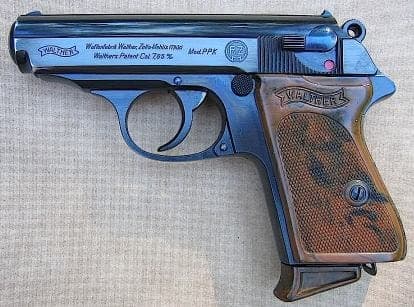
Q. Hi, I have the action of an 1898 Krag that I am refinishing at home. My desired bluing color is a very /blue/ gloss, kind of a peacock blue. How can I achieve this with hot salt bluing? Thank you very much in advance for any help you can give.
Guy Otwell
- Katy, Texas
April 4, 2013
Q. My question is on hot bluing. I am having a problem with the barrel from a 1922 winchester 20 gauge; the front end looks great, the back is not so great. I was in a rush to polish it, forgot about it and turned the fire out under pan and realized that I had one more barrel to do so I hurried and polished barrel turned fire back on and went for it. Anyone have this happen before?
Eric Favre- Waveland mississippi
October 25, 2015
Receiver came back from gun shop with copper color
July 7, 2016Q. I took my Harrington & Richardson ( 1963, SN starts with AX......) topper model 88 single shot 12 gauge to the gun smith. When I picked it up the receiver was copper looking (very shiny like a new copper penny), and the barrel turned out like it should.

I have no idea if the copper will turn color with age down the road or even if it will start rusting tomorrow. I have never seen or heard of such a thing. So if anyone could tell me what to expect, It would be greatly appreciated.
Randy Bucher- DENTON North Carolina USA
A. What you see is typical when a cast iron receiver is run through a standard black oxide line that is for steel. I believe the silicon content of the casting causes this specific color. In my opinion this "color" will have the same wear resistance as your barrel which of course came out black.
Some suppliers of hot black oxide chemicals make a special kind of salt which will turn the cast iron receiver black.
- Whigham Georgia USA
September 14, 2016
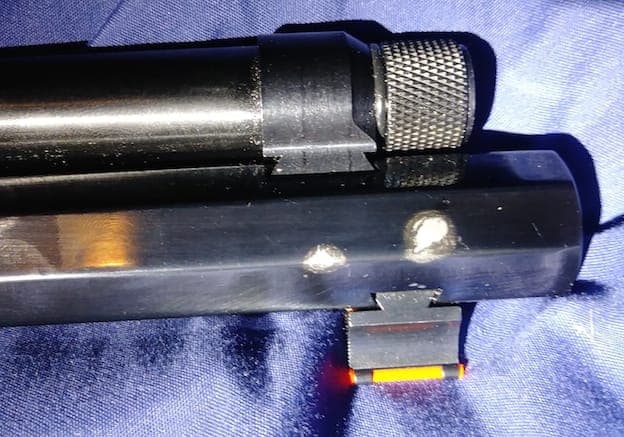
Q. Took my Henry .357 to a gunsmith to change the sights. He used Alumablack and there are two spots where the bluing completely came off. Any idea why this happened?
Adilene Guzman- Los Angeles, California
February 15, 2018
A. Hi Adilene. The gun probably wasn't clean or is corroded at those spots. Neither bluing nor anything else sticks well on wax, oil, grease, or dirt; and poorly adhering oxides from corrosion can rub right off, taking any bluing with them.
Regards,

Ted Mooney, P.E. RET
Striving to live Aloha
finishing.com - Pine Beach, New Jersey
Ted is available for instant help
or longer-term assistance.
Comment: I have a Taurus Judge and it all of a sudden started getting rust on the cylinder. I got all the rust off of it and reblued it with a leading liquid and it still rusts. I tried the paste and it still rusts. I thought this is crazy and in a last ditch effort sanded down the cylinder again for the 3rd time. By the way, after using the liquid and paste, the gun rusted overnight.
Well after the last sanding I rubbed down with transmission fluid. YES I KNOW. But after 5 days no rust. I rub it down once a week and no rust ... and the partially blued and steel look on the cylinder is awesome.
Don weaver- Leesburg Georgia
December 31, 2018
A. Hi Don, oil is the whole secret -- whether it's transmission fluid or another oil. Cold bluing offers no rust resistance at all, and hot bluing offers almost none. I suspect that at some point either overzealous cleaning or time-&-tide removed the protective oil, leaving it prone to flash rusting.
Regards,

Ted Mooney, P.E. RET
Striving to live Aloha
finishing.com - Pine Beach, New Jersey
Ted is available for instant help
or longer-term assistance.
January 2019
Why did most of the part accept bluing except a 3 inch section?
Q. I too have noticed that some parts don't accept bluing despite that the materials are well degreased and well cleaned with gasoline. What's interesting is that one barrel was blued well except 3 inches still not blued can you please help me? Best regards.
Ali zhrani- Aseoy, Egypt
May 22, 2019
A. Hi Ali. The defect may have been random due to improper cleaning. Neither extremely hazardous gasoline, nor any other solvent-style cleaner should be the last step. Alkaline water-based cleaning must be the last cleaning step.
Luck & Regards,

Ted Mooney, P.E. RET
Striving to live Aloha
finishing.com - Pine Beach, New Jersey
Ted is available for instant help
or longer-term assistance.
Q, A, or Comment on THIS thread -or- Start a NEW Thread
